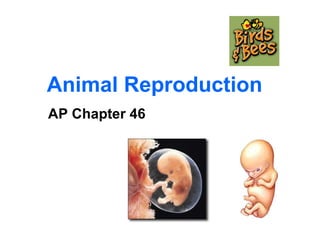
Ap chap 46 animal reproduction
- 1. Animal Reproduction AP Chapter 46
- 5. Fig. 46-1
- 7. What about hermaphrodites self-fertilizing? This is sexual reproduction since this involves the union of eggs and sperm and these are not identical due to meiosis and crossing-over.
- 11. Fig. 46-6
- 14. Fig. 46-7 Accessory gland Ejaculatory duct Testis Vas deferens Seminal vesicle Penis Ovary Oviduct Spermatheca Vagina Accessory gland (a) Male honeybee (drone) (b) Female honeybee (queen)
- 17. Fig. 46-10 Oviduct Ovary Uterus (Urinary bladder) (Pubic bone) Urethra (Rectum) Cervix Vagina Shaft Glans Prepuce Clitoris Labia minora Labia majora Vaginal opening Ovaries Uterus Follicles Oviduct Cervix Corpus luteum Uterine wall Endometrium Vagina
- 21. Path of the Egg
- 23. Fig. 46-11 Seminal vesicle (behind bladder) (Urinary bladder) Prostate gland Bulbourethral gland Erectile tissue of penis Urethra Scrotum Vas deferens Epididymis Testis Seminal vesicle (Urinary bladder) (Urinary duct) (Rectum) Vas deferens Ejaculatory duct Prostate gland Bulbourethral gland Vas deferens Epididymis Testis Scrotum (Pubic bone) Erectile tissue Urethra Glans Prepuce Penis
- 29. Fig. 46-12a Epididymis Seminiferous tubule Testis Cross section of seminiferous tubule Sertoli cell nucleus Primordial germ cell in embryo Mitotic divisions Spermatogonial stem cell Mitotic divisions Mitotic divisions Spermatogonium Primary spermatocyte Meiosis I Meiosis II Secondary spermatocyte Lumen of seminiferous tubule Plasma membrane Tail Neck Midpiece Head Mitochondria Nucleus Acrosome Spermatids (at two stages of differentiation) Early spermatid Differentiation (Sertoli cells provide nutrients) Sperm 2 n 2 n 2 n n n n n n n n n n n
- 30. Fig. 46-12f Ovary Primary oocyte within follicle Ruptured follicle Growing follicle Mature follicle Ovulated secondary oocyte Corpus luteum Degenerating corpus luteum
- 31. Fig. 46-12g Primordial germ cell Mitotic divisions Oogonium Mitotic divisions Primary oocyte (present at birth), arrested in prophase of meiosis I Completion of meiosis I and onset of meiosis II Secondary oocyte, arrested at metaphase of meiosis II First polar body Ovulation, sperm entry Completion of meiosis II Second polar body Fertilized egg 2 n 2 n n n n n In embryo In Embryo At fertilization At puberty
- 33. Fig. 46-UN1 Gametogenesis Spermatogenesis Oogenesis Primary spermatocyte Primary oocyte Polar body Secondary spermatocytes Secondary oocyte Spermatids Sperm Polar body Fertilized egg n 2 n 2 n n n n n n n n n n n n n n
- 38. Fig. 46-13 Hypothalamus GnRH FSH Anterior pituitary Sertoli cells Leydig cells Inhibin Spermatogenesis Testosterone Testis LH Negative feedback Negative feedback – – –
- 43. Fig. 46-14a Control by hypothalamus Inhibited by combination of estradiol and progesterone Stimulated by high levels of estradiol Inhibited by low levels of estradiol Hypothalamus GnRH Anterior pituitary FSH LH Pituitary gonadotropins in blood LH FSH FSH and LH stimulate follicle to grow LH surge triggers ovulation Ovarian cycle Growing follicle Maturing follicle Corpus luteum Degenerating corpus luteum Follicular phase Ovulation Luteal phase (a) (b) (c) Days 0 5 10 14 15 20 25 28 | | | | | | | | – – +
- 46. Fig. 46-14b Ovarian hormones in blood Peak causes LH surge Estradiol level very low Estradiol Progesterone Ovulation Progesterone and estra- diol promote thickening of endometrium Uterine (menstrual) cycle Endometrium 0 5 10 14 20 25 28 | | | | | | | | Days 15 Menstrual flow phase Proliferative phase Secretory phase (d) (e)
- 62. Fig. 46-15 Ovary Uterus Endometrium (a) From ovulation to implantation (b) Implantation of blastocyst Cleavage Fertilization Ovulation Cleavage continues The blastocyst implants Trophoblast Inner cell mass Cavity Blastocyst Endo- metrium 1 2 3 4 5
- 73. Week 4: How you looked at 1 month past conception....
- 76. And then, before you know it...
- 80. Fig. 46-16 Placenta Uterus Umbilical cord Chorionic villus, containing fetal capillaries Maternal blood pools Maternal arteries Maternal veins Maternal portion of placenta Fetal arteriole Fetal venule Umbilical cord Fetal portion of placenta (chorion) Umbilical arteries Umbilical vein
- 81. Fig. 46-17 (a) 5 weeks (b) 14 weeks (c) 20 weeks
- 82. Fig. 46-18 Estradiol Oxytocin from ovaries Induces oxytocin receptors on uterus from fetus and mother’s posterior pituitary Stimulates uterus to contract Stimulates placenta to make Prostaglandins Stimulate more contractions of uterus Positive feedback + +
Notes de l'éditeur
- Figure 46.1 How can each of these earthworms be both male and female?
- Figure 46.5 External fertilization
- Figure 46.6 Parental care in an invertebrate
- Figure 46.7 Insect reproductive anatomy
- Figure 46.10 Reproductive anatomy of the human female
- Figure 46.11 Reproductive anatomy of the human male
- Figure 46.12 Human gametogenesis
- Figure 46.12 Human gametogenesis For the Cell Biology Video Motion of Isolated Flagellum, go to Animation and Video Files. For the Cell Biology Video Flagellum Movement in Swimming Sperm, go to Animation and Video Files.
- Figure 46.12 Human gametogenesis
- Figure 46.12 Human gametogenesis
- Figure 46.13 Hormonal control of the testes
- Figure 46.14 The reproductive cycle of the human female
- Figure 46.14 The reproductive cycle of the human female
- Figure 46.15 Formation of the zygote and early post-fertilization events
- Figure 46.16 Placental circulation
- Figure 46.17 Human fetal development
- Figure 46.18 A model for the induction of labor